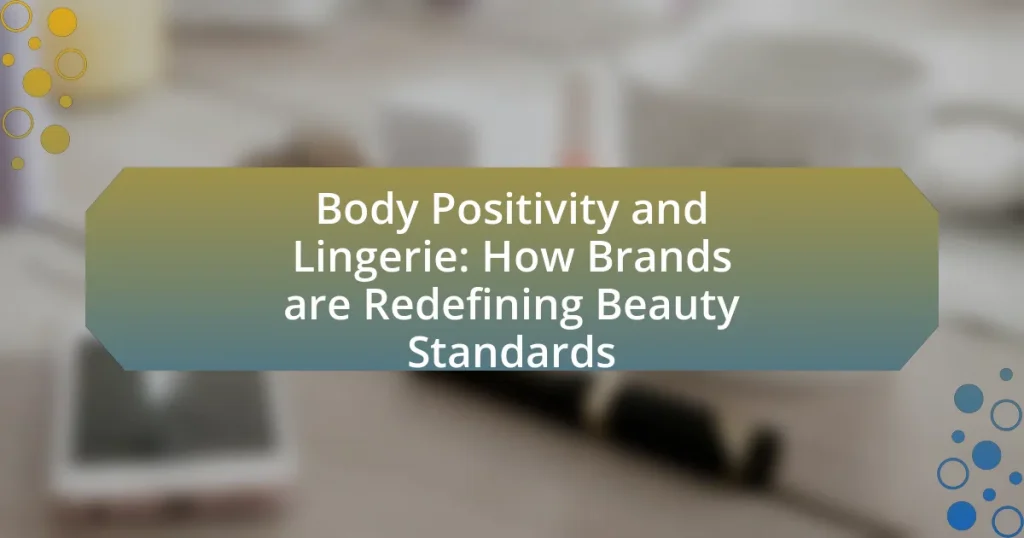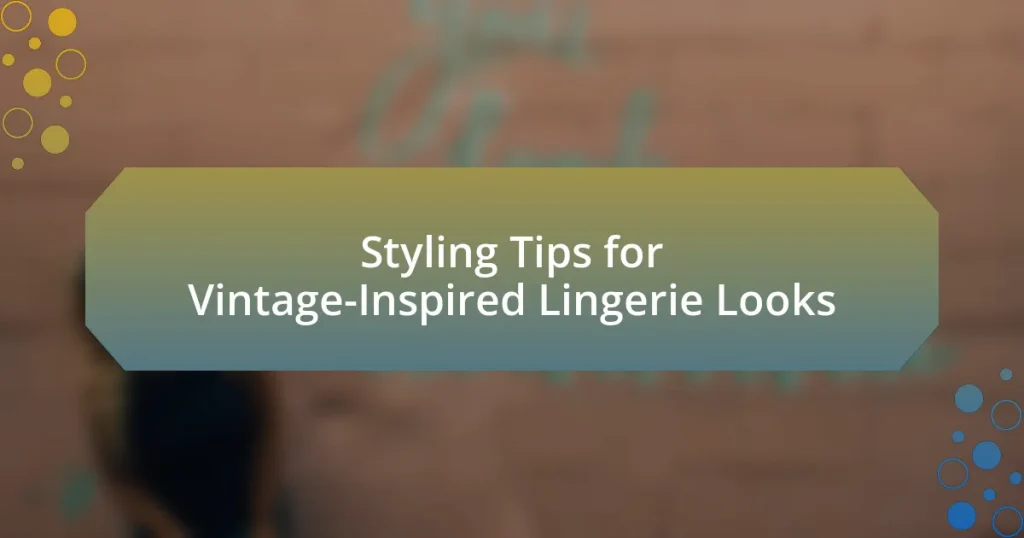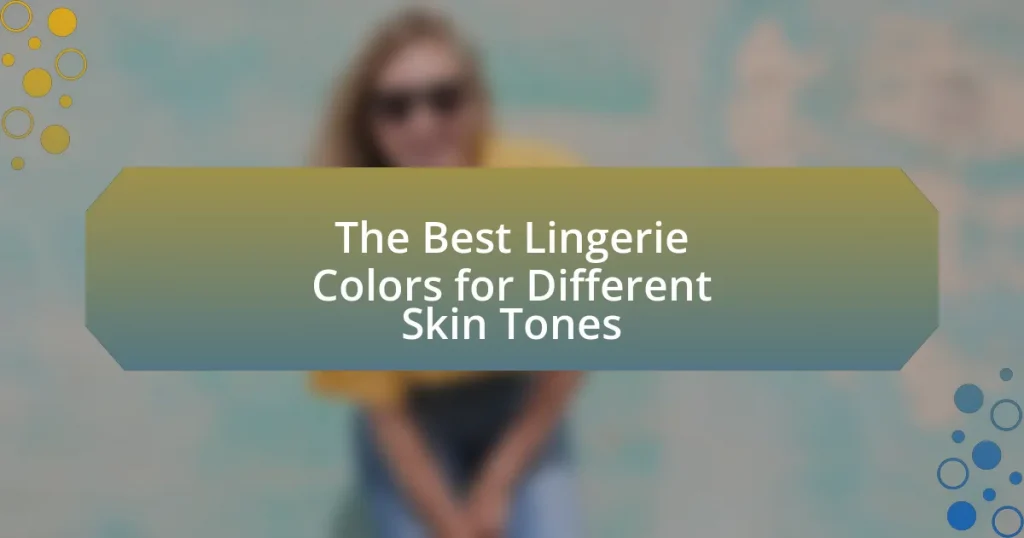Body positivity in the context of lingerie emphasizes the acceptance of all body types, encouraging individuals to embrace their unique shapes when selecting lingerie. This movement challenges traditional beauty standards by promoting inclusivity and diversity in lingerie marketing and design, with brands increasingly offering a wider range of sizes and representations. The article explores the evolution of body positivity, cultural influences, the role of social media, and the impact on consumer behavior and brand loyalty. It also discusses the challenges brands face in promoting body positivity and outlines effective strategies for fostering authentic messaging and representation in the lingerie industry.

What is Body Positivity in the Context of Lingerie?
Body positivity in the context of lingerie refers to the movement that promotes acceptance of all body types and encourages individuals to embrace their unique shapes and sizes when choosing lingerie. This movement challenges traditional beauty standards that often prioritize slimness and specific body ideals, advocating instead for inclusivity and diversity in lingerie marketing and design. Brands are increasingly responding to this shift by offering a wider range of sizes, styles, and representations in their advertising, which reflects the belief that all bodies deserve to feel beautiful and confident in lingerie. This approach is supported by research indicating that body positivity can lead to improved self-esteem and mental health, as individuals feel validated and represented in the products they choose.
How has the concept of body positivity evolved in recent years?
The concept of body positivity has evolved significantly in recent years, shifting from a focus on merely accepting diverse body types to actively celebrating and promoting inclusivity across all shapes and sizes. This evolution is evidenced by the increasing representation of various body types in media and advertising, particularly within the lingerie industry, where brands like Aerie and Savage X Fenty have embraced models of different sizes, ethnicities, and abilities. Research indicates that this shift has positively impacted consumer perceptions, with a 2021 study by the American Psychological Association showing that inclusive marketing can enhance brand loyalty and consumer trust.
What cultural shifts have influenced body positivity in lingerie?
Cultural shifts such as the rise of the body positivity movement, increased representation of diverse body types in media, and the rejection of traditional beauty standards have significantly influenced body positivity in lingerie. The body positivity movement, which gained momentum in the 2010s, advocates for the acceptance of all body shapes and sizes, encouraging brands to create lingerie that caters to a wider audience. Additionally, social media platforms have amplified voices advocating for inclusivity, leading to brands like Aerie and Savage X Fenty embracing diverse models and promoting self-love. This shift is supported by research indicating that 67% of women feel more confident when they see diverse body types represented in advertising, highlighting the impact of cultural changes on consumer perceptions and brand strategies in the lingerie industry.
How do social media and influencers play a role in this evolution?
Social media and influencers significantly contribute to the evolution of body positivity in the lingerie industry by amplifying diverse body representations and challenging traditional beauty standards. Platforms like Instagram and TikTok allow influencers to showcase their bodies in various lingerie styles, promoting acceptance of all shapes and sizes. For instance, campaigns featuring plus-size models have gained traction, leading to increased visibility and sales for brands that embrace inclusivity. According to a study by the American Psychological Association, exposure to diverse body types on social media can improve body image and self-esteem among viewers, further validating the positive impact of influencers in this movement.
Why is body positivity important for lingerie brands?
Body positivity is important for lingerie brands because it fosters inclusivity and promotes a healthier self-image among consumers. By embracing diverse body types, lingerie brands can connect with a broader audience, enhancing customer loyalty and brand reputation. Research indicates that 67% of women feel more confident when they see models of various sizes in advertising, demonstrating that representation can significantly impact consumer perception and purchasing behavior. This shift towards body positivity not only aligns with societal trends advocating for diversity but also drives sales, as brands that prioritize inclusivity often experience increased market share and customer engagement.
What impact does body positivity have on consumer behavior?
Body positivity significantly influences consumer behavior by encouraging individuals to embrace diverse body types, which in turn affects their purchasing decisions. This movement has led brands to adopt inclusive marketing strategies, resulting in increased consumer loyalty and engagement. For instance, a study by the Journal of Consumer Research found that brands promoting body positivity saw a 20% increase in sales among consumers who identified with the represented body types. Additionally, consumers are more likely to support brands that align with their values regarding body acceptance, leading to a shift in market dynamics where inclusivity becomes a competitive advantage.
How does embracing body positivity affect brand loyalty?
Embracing body positivity significantly enhances brand loyalty by fostering a deeper emotional connection between consumers and brands. When brands promote body positivity, they resonate with diverse consumer identities, leading to increased trust and relatability. Research indicates that 67% of consumers are more likely to purchase from brands that reflect their values, including body inclusivity. This alignment cultivates a loyal customer base, as individuals feel represented and valued, ultimately driving repeat purchases and positive word-of-mouth.

How are Lingerie Brands Redefining Beauty Standards?
Lingerie brands are redefining beauty standards by promoting body positivity and inclusivity in their marketing and product offerings. These brands are increasingly featuring diverse models of various sizes, shapes, and ethnicities in their campaigns, which challenges traditional beauty norms. For instance, brands like Aerie and Savage X Fenty have gained recognition for their commitment to showcasing real bodies, with Aerie reporting a 20% increase in sales after launching its #AerieREAL campaign that features unretouched photos of models. This shift not only empowers consumers but also reflects a broader societal movement towards acceptance of all body types, making lingerie more accessible and relatable to a wider audience.
What strategies are brands using to promote body positivity?
Brands are using diverse strategies to promote body positivity, including inclusive marketing, diverse representation, and community engagement. Inclusive marketing involves showcasing models of various body types, sizes, and ethnicities in advertising campaigns, which helps to challenge traditional beauty standards. For instance, brands like Aerie and Savage X Fenty have gained recognition for featuring unretouched images of models with different body shapes, thereby fostering a more realistic portrayal of beauty.
Diverse representation extends beyond advertising; brands are also creating product lines that cater to a wider range of body types, ensuring that all consumers feel represented and valued. For example, lingerie brands are increasingly offering extended size ranges and adaptive designs to accommodate different needs.
Community engagement is another key strategy, where brands actively participate in conversations around body positivity through social media campaigns and partnerships with body-positive influencers. This approach not only amplifies diverse voices but also builds a supportive community around the brand, reinforcing its commitment to body positivity.
These strategies collectively contribute to a cultural shift towards acceptance and celebration of all body types, aligning with the growing demand for authenticity and inclusivity in the fashion industry.
How do inclusive sizing and diverse models contribute to this effort?
Inclusive sizing and diverse models significantly enhance body positivity by promoting representation and accessibility in the lingerie industry. By offering a wider range of sizes, brands cater to a broader audience, ensuring that individuals of all body types feel seen and valued. Research indicates that 67% of women feel more confident when they see models that reflect their own body shape, demonstrating the psychological impact of representation. Furthermore, diverse models challenge traditional beauty standards, fostering a more inclusive narrative that celebrates all forms of beauty. This shift not only empowers consumers but also drives brands to adopt more ethical practices, aligning with the growing demand for inclusivity in fashion.
What marketing campaigns have successfully embraced body positivity?
A notable marketing campaign that has successfully embraced body positivity is Aerie’s “Aerie Real” campaign. Launched in 2014, this initiative featured unretouched photos of models of diverse body types, promoting the message that all bodies are beautiful. The campaign led to a significant increase in sales, with Aerie reporting a 20% sales growth in the year following the campaign’s launch. Another impactful campaign is Dove’s “Real Beauty” initiative, which began in 2004 and focused on celebrating women of all shapes, sizes, and ethnicities. This campaign has been credited with changing the conversation around beauty standards and has garnered numerous awards for its positive impact on body image. Both campaigns exemplify how brands can effectively promote body positivity while achieving commercial success.
Why is representation crucial in lingerie advertising?
Representation is crucial in lingerie advertising because it fosters inclusivity and reflects the diverse body types of consumers. By showcasing a variety of shapes, sizes, and ethnicities, brands can challenge traditional beauty standards and promote body positivity. Research indicates that 67% of women feel more confident when they see models who resemble them in advertising, highlighting the impact of representation on self-esteem and consumer engagement. This approach not only resonates with a broader audience but also drives brand loyalty, as consumers increasingly prefer brands that align with their values of diversity and acceptance.
How does representation affect the perception of beauty standards?
Representation significantly influences the perception of beauty standards by shaping societal norms and ideals. When diverse body types, ethnicities, and genders are represented in media and advertising, it challenges traditional beauty norms and promotes inclusivity. Research by the American Psychological Association indicates that exposure to varied representations can enhance body image satisfaction among individuals, particularly those who identify with the represented groups. This shift in representation encourages acceptance of different beauty standards, ultimately leading to a broader definition of beauty that includes all body types and appearances.
What are the consequences of lack of representation in lingerie marketing?
The lack of representation in lingerie marketing leads to negative body image and reinforces harmful beauty standards. When marketing predominantly features a narrow range of body types, it alienates consumers who do not see themselves reflected in the imagery, resulting in feelings of inadequacy and low self-esteem. Research indicates that exposure to diverse body representations can improve body satisfaction; for instance, a study published in the journal “Body Image” found that women exposed to images of various body types reported higher body satisfaction levels. Furthermore, brands that fail to embrace inclusivity risk losing market share, as consumers increasingly prefer companies that align with their values of diversity and body positivity.

What Challenges Do Brands Face in Promoting Body Positivity?
Brands face significant challenges in promoting body positivity, primarily due to societal beauty standards and consumer skepticism. Societal beauty standards often dictate narrow definitions of attractiveness, making it difficult for brands to authentically represent diverse body types without facing backlash. Additionally, consumer skepticism arises from past instances where brands have used body positivity as a marketing gimmick rather than a genuine commitment, leading to distrust among consumers. According to a study by the American Psychological Association, 70% of women report feeling pressure to conform to unrealistic beauty ideals, which complicates brands’ efforts to create inclusive campaigns that resonate with their audience.
How do traditional beauty standards conflict with body positivity?
Traditional beauty standards often conflict with body positivity by promoting narrow definitions of attractiveness that emphasize thinness, youth, and specific physical features. These standards create societal pressure to conform, leading to negative body image and self-esteem issues among individuals who do not fit these ideals. Research indicates that exposure to traditional beauty ideals can increase body dissatisfaction, as evidenced by a study published in the journal “Body Image,” which found that women exposed to idealized images reported lower self-esteem and higher levels of body shame. In contrast, body positivity advocates for acceptance of all body types, challenging the notion that beauty is limited to specific characteristics and promoting a more inclusive understanding of self-worth.
What barriers do brands encounter when changing their messaging?
Brands encounter several barriers when changing their messaging, particularly in the context of body positivity and lingerie. One significant barrier is consumer skepticism, as audiences may doubt the authenticity of a brand’s commitment to body positivity if they perceive it as a marketing ploy rather than a genuine shift in values. Additionally, brands face internal resistance, where stakeholders may be hesitant to embrace new messaging due to fear of alienating existing customers or disrupting established brand identities. Market competition also poses a challenge, as brands must differentiate their messaging in a crowded space where many are adopting similar narratives. Furthermore, regulatory and societal pressures can complicate messaging changes, as brands must navigate cultural sensitivities and potential backlash from various groups. These barriers highlight the complexities brands face in aligning their messaging with evolving beauty standards while maintaining credibility and market relevance.
How can brands overcome resistance from consumers or industry norms?
Brands can overcome resistance from consumers or industry norms by actively promoting body positivity and inclusivity in their marketing strategies. By showcasing diverse body types and using real customers in advertising, brands can challenge traditional beauty standards and resonate with a broader audience. For instance, Aerie, a lingerie brand, has seen a 20% increase in sales after eliminating retouching in their campaigns, demonstrating that authenticity can drive consumer acceptance and loyalty. Additionally, engaging with consumers through social media platforms allows brands to foster community and dialogue, further reducing resistance by aligning with consumer values and expectations.
What role do consumer expectations play in this landscape?
Consumer expectations significantly influence the body positivity movement within the lingerie industry by driving brands to adopt more inclusive marketing strategies and product offerings. As consumers increasingly demand representation and diversity in body types, brands are responding by featuring models of various sizes and shapes, which aligns with the growing societal emphasis on body acceptance. For instance, a study by the American Psychological Association found that 70% of women feel more positively about brands that promote body diversity, indicating that consumer expectations are reshaping brand practices and messaging. This shift not only enhances brand loyalty but also reflects a broader cultural change towards embracing all body types, thereby redefining beauty standards in the lingerie market.
How can brands balance consumer expectations with body positivity initiatives?
Brands can balance consumer expectations with body positivity initiatives by integrating diverse body representations in their marketing while maintaining product quality and fit. This approach addresses the growing consumer demand for inclusivity, as studies show that 67% of consumers prefer brands that promote body positivity. By showcasing models of various sizes and shapes, brands can resonate with a broader audience, fostering a sense of belonging and acceptance. Additionally, brands can engage in transparent communication about their sizing and fit, ensuring that consumers feel confident in their purchases. This strategy not only meets consumer expectations but also aligns with the values of body positivity, ultimately enhancing brand loyalty and trust.
What feedback mechanisms can brands use to gauge consumer sentiment?
Brands can use surveys, social media monitoring, and customer reviews as feedback mechanisms to gauge consumer sentiment. Surveys allow brands to collect direct responses from consumers regarding their feelings and perceptions about products, while social media monitoring enables brands to analyze public discussions and sentiments expressed online. Customer reviews provide insights into individual experiences and satisfaction levels, helping brands understand consumer preferences and areas for improvement. These methods are effective as they provide quantifiable data and qualitative insights, allowing brands to adapt their strategies in alignment with consumer expectations.
What are some best practices for brands to effectively promote body positivity?
Brands can effectively promote body positivity by showcasing diverse body types in their marketing campaigns. This approach not only reflects the reality of their customer base but also fosters inclusivity and acceptance. For instance, brands like Aerie have gained significant attention by featuring unretouched images of models of various sizes, which has led to a 20% increase in sales, demonstrating the positive impact of authentic representation. Additionally, engaging in community initiatives that support body positivity, such as partnerships with organizations focused on mental health and self-esteem, further solidifies a brand’s commitment to this movement. By prioritizing transparency and authenticity in their messaging, brands can build trust and resonate with consumers who value body positivity.
How can brands create authentic messaging around body positivity?
Brands can create authentic messaging around body positivity by showcasing diverse body types in their marketing campaigns and using real customers as models. This approach not only reflects the reality of their consumer base but also fosters a sense of inclusivity and acceptance. Research indicates that 67% of consumers are more likely to purchase from brands that promote body positivity and diversity in their advertising (Dove’s “Real Beauty” campaign). By prioritizing representation and authenticity, brands can build trust and loyalty among their audience, ultimately redefining beauty standards in the lingerie industry.
What partnerships or collaborations can enhance body positivity efforts?
Collaborations between lingerie brands and body positivity advocates can significantly enhance body positivity efforts. For instance, partnerships with influencers who promote diverse body types can amplify messages of inclusivity and self-acceptance. Research indicates that campaigns featuring models of various sizes lead to increased consumer engagement and positive brand perception, as seen in Aerie’s #AerieREAL campaign, which showcased unretouched images of models and resulted in a 20% sales increase. Additionally, collaborations with mental health organizations can provide resources and support for individuals struggling with body image issues, further solidifying the commitment to body positivity within the lingerie industry.















